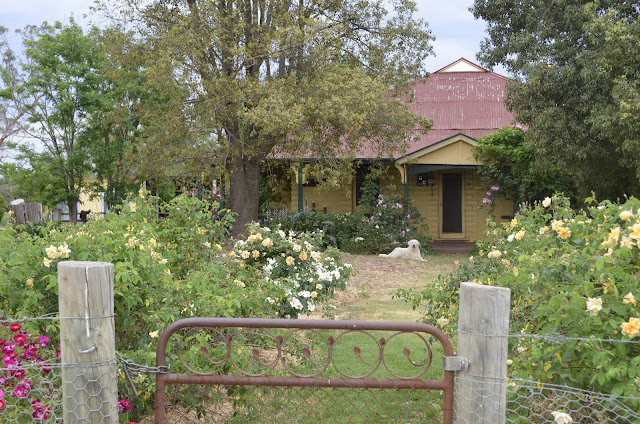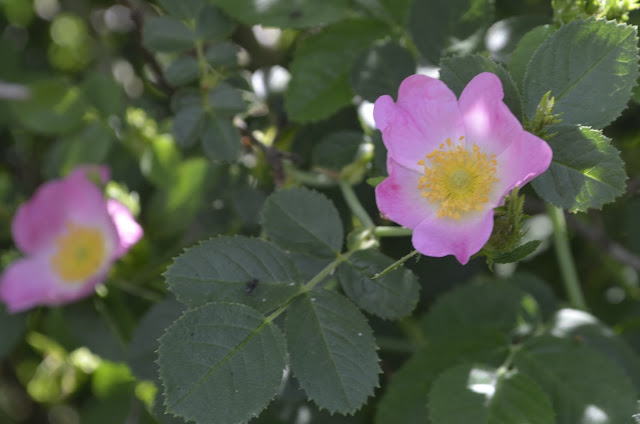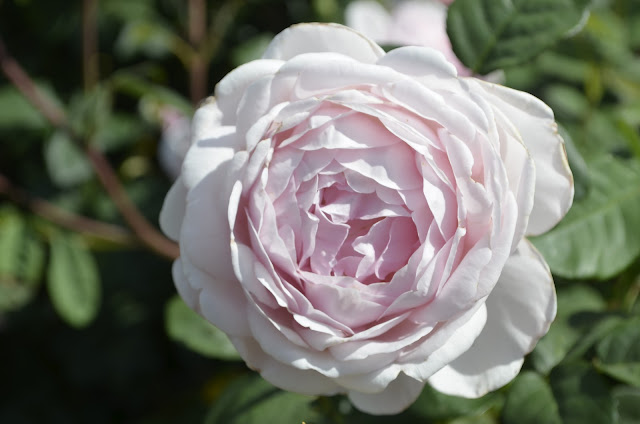Tuesday, November 6, 2012
General Garden Scenes
Above: View from the front door, looking due East: Isabella Sprunt, Sally Holmes, Crepuscule and Francesca.
Above: Sally Holmes and Crepuscule.
Above: In the foreground are two plants of Sally Holmes, planted last year, then Crepuscule, and then a double row of four of the hybrid musk rose 'Francesca'.
Above: Roberta the Garden Fairy wonkily leaning backwards into a sea of Cousin Essie. At her feet is a 12 month old specimen of Jean Ducher, with Celtic Blessing in the centre.
Above: The newest section of garden with roses planted mainly in the winter of 2011, with a couple banged in this year. They are a real mixture, with quite obscure ROR varieties such as Mrs Bushby's Bourbon and Rose From Tapio Station, joined by Mme Isaac Perriere, L'Ouche and a tea or two. I have had numerous breakages of canes, and worse, because this area is where the three dogs gallop up and down the fence line when a vehicle drives past. It is also where the dogs chase calves or cows that happen to stray into the garden, so it is amazing that anything survives in this bed!
Above: The rugosa seedling "nursery bed" in which the new little rugosa seedlings were planted over ten years ago. There are three different seedlings growing here, my favourite being the one on this end. The lighter obviously "non-rugosa" plant seen above the fence post in the corner of the photo is a Cottage Pink multiflora rambler.
Above: My babies again.
Above: Looking west from our front gate..the rows of Francesca, Crepuscule,Sally Holmes on the left, Wildflower on the right, and finishing off both sides with Isabella Sprunt.(and a rude red splodge of Dr Huey in the front left hand corner!)
Above: An oldie but a goodie...the beautiful Constance Spry, one of David Austin's first creations.
Monday, November 5, 2012
Fruhlingsduft (again!!!)
I know that I have posted what seems like dozens of photos of the magnificent Fruhlingsduft on my blog, but I just can't wander past it at this time of the year without yearning to point my camera in its direction. So prolific, so very beautiful...an absolute must-have garden rose.
Sunday, November 4, 2012
Sweet Briar
I have loved the Sweet Briar rose since the very first time that I crushed its leaves and held them under my nose with my eyes closed...had I not known better, I would have bet a million dollars that it was freshly-sliced crisp green apple in my hands. When it rains, this apple scent radiates out from the plant...it really is an absolute delight.
Having said this, it is considered a weed in certain states of Australia. For example, the following comes from the Victorian Department of Primary Industries:
Scientific name: Rosa rubiginosa L. (Synonym R. eglanteria)
Common Name: Sweet briar, Briar rose, Wild rose.
Sweet briar is native to Europe and western Asia and northern India. Sweet briar was first recorded in Victoria in the 1850s and had established over large areas by 1917. It is now widespread in a variety of cooler, higher rainfall habitats including farmland, woodlands, and stony rises of the volcanic plains, along roadsides and in other disturbed areas.
Sweet briar establishes in areas of moderate soil fertility where there are low levels of grazing. It reproduces from seed and perennial roots and suckers readily from the crown.
Sweet briar is a perennial woody shrub up to 3m tall.
Stems - usually many (and can be up to several hundred) stems arising from the rootstock; erect or scrambling, up to 3 metres high, green and smooth to brown and somewhat roughened, woody, branched, spreading and sometimes trailing, heavily covered with down-curved prickles up to 1.5 cm long.
Flowers - pink or white, 2.5 - 4 cm diameter, on short prickly stalks, occurring in loose clusters at the ends ofstems or branches. Each flower has 5 petals, 8 to 25 mm long, numerous yellowish stamens and five elongated spiny sepals prominent at the base.
Fruit - commonly referred to as a ‘hip’. A smooth or hairy and bristly, egg-shaped capsule, 15 to 20 mm long. Whenripe the hips are orange to red to almost black. The sepals often remain attached to the top of the hip. The hips are shed in Autumn after leaf fall.
Seeds - yellow, 4 to 7 mm long and irregularly shaped.
Roots - stout, shallow and extensively spreading.
Infestations can rapidly take over woodland areas. Patches of the weed can impede the movement of grazing animals and cause serious mechanical injury to stock and dogs. Sweet briar provides harbour for rabbits and other pest animals.
Although a non desirable species, Sweet briar has some favourable characteristics. The hips are a rich source of vitamin C and can be eaten raw. They are used in wines, sauces and jellies. Sweet briar is of some value to apiarists as a source of pollen.
The plant has little or no value as fodder for stock.
This is also a Sweet Briar variety that came up from seed. I planted together two seedlings that were growing at the base of the parent plant (which has since died). Both have the apple scent, but the flowers are slightly different- one being single and the other as above.
Sceptre'd Isle
I am an absolute sucker for David Austin's myrrh-scented roses, and the pretty soft-pink Sceptre'd Isle is no exception. It is so prolific and strongly scented you can smell the fragrance well without sinking your face into the bloom. It opens very cupped, then relaxes to display the yellow stamens as it ages. I have several specimens in the garden, and all have grown to six feet, vigorous and disease-free.
Cornelia- Hybrid Musk Rose
The lovely hybrid musk rose Cornelia is sensational this Spring, with her blooms being a deeper shade of apricot-pink than usual. I could smell her sweet musky fragrance from the distance I was standing to take this photo...there really is no class of rose to beat hybrid musks for the powerful scent of their blooms.
Mittagong Gallica
I was amazed to spy this little rose flowering in the garden this morning...it was in the harshest spot in the entire garden- the south-west corner- that comes under the influence of a huge old gum tree and never gets watered or tended to at all. It is the domain of a seedling White Cedar tree, various suckering seedling rugosas and a lonely specimen of Lord Penzance. So to see this unexpected little bloom amongst that crew made me investigate further. Thankfully a faded plastic name tag lay at the base of the plant, and on it I was just able to make out the words "Mittagong Gallica". This rang a faint bell as a rose given to me by old rose saviour Jane Zammitt, and I was delighted to discover that it was still alive and doing well. It has suckered nicely withing a couple of feet of the original plant, so with any luck (and a bit of TLC) Mittagong Gallica is here to stay. I can't find any information at all about this rose, so if anyone knows anything of its provenance I would love to hear from them.
Lady Hillingdon- Tea Rose
Lady Hillingdon is one of my favourite tea roses. She is a 20th Century tea, being released in England in 1910, and handles the hot, harsh conditions of Summer in our back garden without missing a beat. Her buds are long and pointed and of a rich apricot colour, and the blooms retain this colour initially before fading prettily to a lighter cream. My grafted specimen has been quite slow to establish as compared to the cutting-grown teas that I have grown, but after several years without pruning it has reached waist-height. It appears to be of the typical branching tea habit, being as wide as it is high. The fragrance is magnificent.
Honorine De Brabant- Bourbon Rose
I have spoken about this gorgeous rose on my blog before, but every Spring I am amazed by her beauty all over again...I turn the corner around the big wisteria climber, and there is Honorine in all of her stripey glory. I love the variety of her blooms...from the faintest of stripes to the deepest of raspberry pink...and her scent is typically sweet Bourbon.
Cannonvale Maroon-Hybrid Perpetual
Cannonvale Maroon is a beautiful "ROR" rose...one that has been found growing either wild or in an old established garden, and without a positive identity. Until that definitive identification is forthcoming, 'ROR' roses are given a "working name", usually reflecting either the location in which it was found, the founder or some other identifying title such as the original owner of the garden.
I can find no information at all regarding this fabulous old rose, which has been growing in my garden for at least ten years. I planted it on a fence line running east-west, so it gets full afternoon sun all summer, and is rarely watered and NEVER mulched. It has other roses growing in front of it, and in fact is never viewed until this time of the year when arching branches laden with fragrant maroon blooms appear over the top of the other roses.
Sunday, October 21, 2012
Yellow Banksia Rose
Left to their own devices, the yellow and white Banksia Roses do not even need a fence or other structure for support...they will over time form big mounds of disease-free, evergreen foliage that are smothered each October and November with clouds of bloom. I personally prefer the white to the yellow...the latter reminds me of a 1960s bridesmaid's dress.
L'Ouche
Back to my own weed-filled garden...
Mutabilis is glorious at the moment...clothed with single blooms of varying shades from brick-red to creamy salmon. This is most definitely a rose to be left alone to its own devices...I would even hide the secateurs behind my back whilst walking past it, such is its hatred of being cut back. My two specimens were pruned seven long years ago, and are still quietly sulking. They bloom prolifically, but have never regained the lovely shrub structure of their former unpruned glory.
Above: The very vigorous Bloomfield Abundance, which in bloom is pretty much identical to the bloom of Climbing Cecile Brunner, with the exception of the length of the length of the sepals. There has been great debate world-wide about the differences between Cecile Brunner, Climbing Cecile Brunner, Spray Cecile Brunner and Bloomfield Abundance...all I know is that whatever the true identity of the three huge specimens that I have here at 'Eurimbla', it is a brilliant, healthy, prolific rose. The delicate little scrolled buds are perfection, and they open into typical old-fashioned blooms, before finally ending up looking almost hybrid-musk in style. We have big shrubs growing at the south-west and north-west corners of our house, and the only downfall of this is the apparent fondness of our resident brown snake population to the latter location...there have been several sightings of snakes that have disappeared into the mound of bloom over the past few years...uuuggghh!!
What a success!!!
Well, the Canowindra Hidden Gardens Day was a spectacular success last Saturday, with over 400 people enjoying the ramble through a selection of very different and spectacular gardens. I was privileged to man the ticket-check at Linda's during the morning session, which basically involved sitting in a beautiful spot chatting to friendly garden lovers...a lovely way to spend two hours on a glorious Spring day.
Thursday, October 18, 2012
Wander around the garden, Thursday afternoon...
Above and below: The perfect blooms of Mme Gregoire.
Above: Rugoas seedling 'Celtic Blessings'.
Above: Non-stop bloomer, David Austin's 'John Clare'.
Above: One of my favourite hybrid musk roses...Bloomfield Dainty.
Above: Tea rose 'Octavus Weld'.
Subscribe to:
Posts (Atom)













































.JPG)
.JPG)


.JPG)
